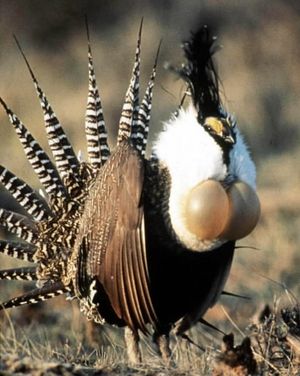Feds list Gunnison sage grouse threatened
ENDANGERED SPECIES -- The Gunnison sage grouse will be listed as threatened under the federal Endangered Species Act, the U.S. Fish and Wildlife Service announced today.
The listing was a downgrade from an earlier agency recommendation — and an acknowledgement of work by Native American tribes and private land owners in Colorado and Utah to cut the threats to the bird in an effort to avoid an endangered listing, according to a Salt Lake Tribune story by Brett Prettyman.
“Efforts by Utah and Colorado, private landowners and tribes have reduced the threats to the bird,” said wildlife service director Dan Ashe. “These investments and protections that have been put in place will pay enormous dividends in the future.”
Wednesday’s announcement left conservationists and state wildlife managers disappointed, but for different reasons. Utah wildlife officials want no federal protection and the wildlife conservation groups want the endangered listing.
The listing comes with an option for a special rule that allows federal officials to relax some ESA restrictions to allow ranchers, farmers and landowners in Colorado and Utah committed to grouse conservation to continue their practies without new restrictions.
Gunnison sage grouse were recognized as a separate species from Greater sage grouse in 2000 and were soon after designated as a candidate for listing under the ESA.
A small percentage of the estimated 4,700 Gunnison sage grouse population inhabits two areas in San Juan County near Monticello. The majority of the birds live in southwestern Colorado.
Conservation advocates say “threatened” status does not provide enough protection for the birds.
“Imperiled by irresponsible grazing, oil and gas drilling, residential development, roads, powerlines and the cumulative impacts of these threats, the fewer than 5,000 remaining Gunnison sage grouse need the strongest possible protections to ensure they survive and recover,” said Erik Molvar, wildlife biologist with WildEarth Guardians. “The science is clear: This spectacular dancing bird is endangered and should be afforded the highest level of protection.”
Utah Division of Wildlife Resources Director Greg Sheehan, however, says more can be done to protect the birds without a federal listing.
“Placing the bird under the oversight of the federal government will greatly reduce our ability to help the bird,” Sheehan said. “Putting the bird under the management authority of the federal government will create roadblocks that will make it difficult to complete work to help the species.”
While Utah and Colorado have provided impressive efforts to restore the species, Ashe said the Fish and Wildlife Service is bound to make listing decisions based on the best available science.
“The law asked us to consider the current and foreseeable future,” Ashe said. “We believe the best science points that while not facing an emminent risk of extinction, which would warrant an endangered listing, that a threatened listing under the Endangered Species Act is the appropriate conclusion.”
Colorado governor John Hickenlooper indicated earlier this week his state would sue if the U.S. Fish and Wildlife Service listed the grouse as endangered or threatened.
The birds, according to the Fish and Wildlife Service, were historically found in the Four Corners area of Colorado, Utah, Arizona and New Mexico.
Gunnison sage grouse are about 1/3 smaller than Greater sage grouse and males show distinct, white barring on their tail feathers.

